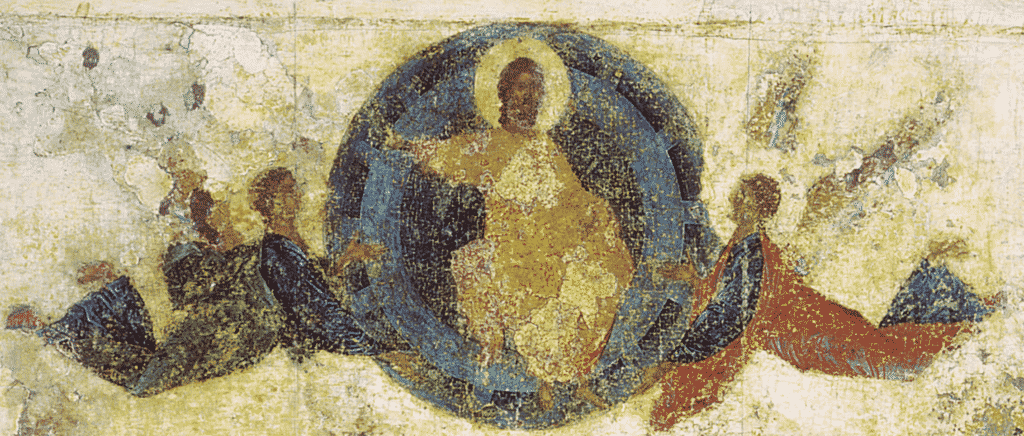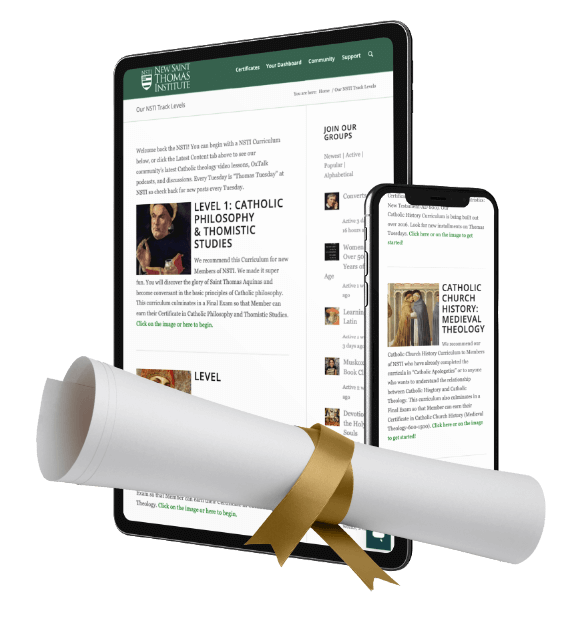Ascension of Christ as Davidic Cloud Monarch
Many of us begin with an incorrect (even heretical) understanding of the Ascension of Christ. I’ve heard it said that Christ eventually “gave up” the use His body, as if he parked it in a garage with the idea of perhaps using His body again at the end of time to judge the living and dead.
Today we will discover the importance in Catholic orthodoxy of the presence of “the cloud” at the Ascension of Christ:

The ascension of Christ is described in Luke’s Gospel and referred to frequently in John. Christ gathers the 11 Apostles at the Mount of Olives where He commands them to remain in Jerusalem until the coming of the Holy Spirit:
And it came to pass, while he blessed them, he parted from them, and was carried up into heaven. And they worshiped him, and returned to Jerusalem with great joy.
We receive more details in Luke’s Acts 1:8-11:
But you shall receive power when the Holy Spirit has come upon you; and you shall be my witnesses in Jerusalem and in all Judea and Samaria and to the end of the earth.” 9 And when he had said this, as they were looking on, he was lifted up, and a cloud took him out of their sight. 10 And while they were gazing into heaven as he went, behold, two men stood by them in white robes, 11 and said, “Men of Galilee, why do you stand looking into heaven? This Jesus, who was taken up from you into heaven, will come in the same way as you saw him go into heaven.”
Perhaps the most important detail here is the description of a “cloud” taking Him out of sight.
Christ did not float up into the sky like a balloon let loose by a child until it disappeared as a dot in the sky too far way to see. Rather, the Body of Christ was taken by a cloud.
Saint Peter perceives the Davidic importance of this event in Acts 2:32-36 when he cites the royal Davidic “Lord said to my Lord” Psalm 110:
The Lord says to my lord:
“Sit at my right hand,
till I make your enemies your footstool.”
2 The Lord sends forth from Zion
your mighty scepter.
Rule in the midst of your foes!
3 Your people will offer themselves freely
on the day you lead your host
upon the holy mountains.
From the womb of the morning
like dew your youth will come to you.
4 The Lord has sworn
and will not change his mind,
“You are a priest for ever
after the order of Melchizedek.”
5 The Lord is at your right hand;
he will shatter kings on the day of his wrath.
6 He will execute judgment among the nations,
filling them with corpses;
he will shatter chiefs
over the wide earth.
7 He will drink from the brook by the way;
therefore he will lift up his head.
This is a Psalm declaring that David will “ascend” to his God-appointed throne at God’s right hand and begin to rule. We find that the Davidic king is at least quasi-divine. He is:
- “my Lord”
- “priest”
- “for ever”
- “will scatter kings…corpses…over the wide earth”
This is a cosmic king. A divine Messiah. Something David could never be and this is why Christ asks how David could ever say: “The Lord says to my Lord.”
This is Trinitarian theology. We find one Divine Person (Lord) speaking to another Divine Person (Lord). For an interesting study of two distinct “Lords” in Hebrew Scripture, I highly recommend The Great Angel: A Study of Israel’s Second God by Margaret Barker.
We see the conversation between the “two Lords” in Daniel 7 with the “Ancient of Days” (first Lord) interacting with the Son of Man (second Lord). In Daniel 7:13, the Son of Man comes up to the Father. I’m not making this up or grasping at straws. Christ Himself quotes these passages as references to Himself in the future at Matthew 24:30; 26:64 and Mark 13:26; 14:62 and Luke 21:27:
13 I saw in the night visions,
and behold, with the clouds of heaven
there came one like a Son of Man,
and he came to the Ancient of Days
and was presented before him.
14 And to him was given dominion
and glory and kingdom,
that all peoples, nations, and languages
should serve him;
his dominion is an everlasting dominion,
which shall not pass away,
and his kingdom one
that shall not be destroyed.
It’s obvious how this passage in Daniel 7 echoes Psalm 110 with a divine-like King gaining universal dominion over all kings and kingdoms. But notice the “clouds.”
See this post for more: The Davidic Identity of Daniel
Christ purposefully includes “the clouds” in His own citation of this passage during His trial. Ultimately, it’s Christ’s quotation of this passage and “the clouds” that offends the High Priest leads Him to be “convicted” and crucified.
The cloud theme continues in Revelation as I detail in this free Catholic podcast on the Book of Revelation Chapter 14. Jesus Christ rides in “on a cloud” holding a sickle and ready to slay his enemies as described in Ps 110 and Dan 7.
Then I looked, and lo, a white cloud, and seated on the cloud one like a son of man, with a golden crown on his head, and a sharp sickle in his hand.
The Ascension of Christ with the cloud is important and it shows that He is still operating through His assumed human nature. This is good news for Catholics. If Christ has “parked His body” as if to be finished with it, then we would not have the perennial presence of the Body and Blood of Christ in our churches.
Happy Ascension,
Dr. Taylor Marshall
[reminder]
PS: King David was Eucharistic. 2 Sam 6:17-19 records that when King David ascended as king in Jerusalem, he gave every Israelite a wheat cake, wine, and a cake of grapes. A type of the wheat and grapes of the Eucharist of the Davidic Messiah.
PPS: Here’s a line by line Catholic commentary on the Book of Revelation.
If you’d like to study with me orthodox Christology (study of Christ) and Mariology (study of Mary) study of Mary, please join the New Saint Thomas Institute.
What to Watch Next
SHOP THE TAYLOR MARSHALL STORE
Dive Deeper

GET CONFIDENT IN YOUR FAITH
Explore the fascinating world of Catholic teachings with Dr. Marshall. Together you’ll unpack the brilliant answers the Church gives to tough questions about the Faith. The best part: you go at your own pace. Start this exciting journey today.


 >
>



